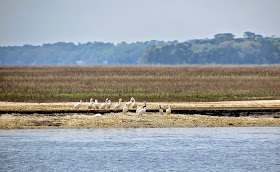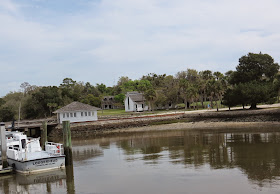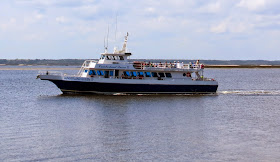Cumberland Island is Georgia's largest and southernmost barrier island. Since its creation as a National Seashore in 1972, the park protects over 9,800 acres of pristine maritime forests, wild beach, freshwater lakes, and saltwater marshes, as well as birds, reptiles, and marine mammals who depend upon its habitat.
A ferry provides transportation to the island.
The ferry leaves from St. Marys, from what used to be Old Millers Dock.This map shows the route of the ferry down the St. Marys River and across Cumberland Sound to the dock on the island. We will only have time to explore the south end because we will only be on the island 2 hours. There are all-day options, and overnight tent camping allowed as well, but must be planned farther in advance.
Boarding the ferry in St. Marys. The blue building in the background is the Visitor Center.
Looking back at the small town of St. Marys.
White pelicans on a sand dune near the salt marshes.
While the wilderness is protected, Cumberland Island has a rich human history that is also being preserved.
Natives, Spanish missionaries, enslaved African Americans, and wealthy industrialists all walked here.
Horses are not native to Cumberland Island. The Spanish may have first brought horses here in the 16th century, however it is unlikely that those survived. Feral horses seen here today are more likely descendants of of horses brought by the English in the 18th century.
Approaching the dock.
The white building is the Ice House Museum and also houses restrooms and a water fountain for refilling your water bottle. There are no other amenities on the island. If you come, bring your own food, insect repellent, sunscreen, etc.
Inside the museum we learn that the foundation of an older general store was found under the ice house during an archaeological dig.
The original tabby foundation can be seen beneath the glass.
In the museum we read about other structures on the north end of the island that we will not have time to see on our visit.
Many mansions have been built on the island by the Carnegie family.
We will tour the ruins of the oldest estate, called Dungeness, built in 1885.
In the early 1880s, Thomas Carnegie (brother to steel magnate Andrew) and his wife, Lucy, came to the island and established the family's presence, and eventually owned over 90 percent of the island. There is still land on the island that is privately owned by the family's descendants.
Wild horses wander the grounds. The herd is estimated to be 150-200 horses...
And growing. Through the years some of the horses have been captured and used…sold to visitors, as calvary animals during the Civil war, for horse meat.
Many former island residents introduced other breeds into the herds in an attempt to improve the animals, and provide additional income. While they are being studied, no management plan is in effect for these horses. They do not have a very long life span due to infestations of parasites and disease.
The island has beautiful old Live Oak trees. They were once harvested by the widow of Revolutionary War hero General Nathanael Greene to pay off debt. Greene had been given land on the island in 1785, and the first Dungeness house built of Tabby (a type of concrete made of lime, shells, gravel, and stones that dries very hard) was built. Greene died before it was completed. That house later burned and a new, grander Dungeness was built by the Carnegies in 1884.
You can walk or rent bicycles to traverse the island today, but imagining the horse-drawn surrey is more fun. This road leads to the Dungeness ruins.Just a burly old tree.
I say ruins, because the second Dungeness was also destroyed by fire in 1959.
Dungeness today.
And then...
Built in the style of a Scottish castle, Dungeness boasted 59 rooms. There were also 40 other buildings built on the estate that included a staff of 200.
Two black vultures stand over the ruins.
Thomas Carnegie died in 1886 before its completion, but his wife Lucy, and her nine children made Dungeness their permanent residence. Eventually several other homes were built on the island for her children.
Lucy Carnegie on the right.
Looking down toward the salt marsh….not sure the purpose of the building there.
More horses.This building house was used for recreation and had a heated swimming pool.
There was also an apartment for a bachelor son.
View of the salt marsh.
In the foreground is the recreation hall, next the castle, and on the far left is the oldest building on the island.
This tabby building was built around 1800 and was the gardeners house for the original Dungeness. It didn't burn, so the Carnegies kept it and used it for offices.
A statue on the grounds.
The pergola (an archway in a garden or park consisting of a framework covered with trained climbing or trailing plants.)More majestic Live Oak trees whose branches have taken root.
Our walking tour took up our two hours, and we didn't get a chance to see much of the wilderness, but a dolphin did entertain us at the dock while we waited for the ferry.
The Carnegies donated most of the island to the National Park Service in 1971. The rest is held in trust as long as there are living descendants.The ferry ride each way was about 45 minutes.
There's a tall ship in the harbor at St. Mary's.
Its flag reads, "Don't Give Up The Ship."
And tomorrow we too shall sail away, in our rolling vessels, to a new adventure a little farther north.





















































So glad to see you posting more frequently again. It was an interesting tour.
ReplyDelete